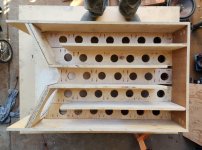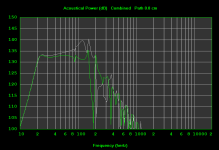Either I haven’t had my coffee and these lines are misleading, or I’m a bit behind about subwoofer development. Is this just a 4th order bandpass sub (albeit mounted at angle ?why)

Looks more like regular 4th order. On the right side there is no second vent - just a large opening, so it is not a bandpass box.
Having run similar alignments through Hornresp before, you end up with something close to a ported box, with a bit of gain at the top end of the bandwidth (or even above the intended bandwidth) from the short horn formed by the baffle arrangement.
Simulate as a tapped horn with a throat chamber.
Chris
Simulate as a tapped horn with a throat chamber.
Chris
Right, AKA BP6S or as Paul Klipsch referred to such alignments as the Karlson K15 as a ('series' per his sketch) four resonant box, this is a series two resonant box and due to the rapid expansion, a crude TH.Simulate as a tapped horn with a throat chamber.
Allen get sit first, the backs of the driver are in the vent, but in a significant flare that likely impacts little.
You are going to get back of driver noises which could be avoided by putting the magnet sinside the box.
dave
You are going to get back of driver noises which could be avoided by putting the magnet sinside the box.
dave
And I dont find any ‘6th order’ tuning in that either though they share the same vent configuration and slight series rear chamber flare
Like it or not, it's a resonant chamber same as a horn or are you claiming a FLH is non resonant?
This "front loaded mass" (not rally a horn) will work in the range of probably 150-200Hz. But this looks like a 18" or similar design, it will be crossed over way lower.Like it or not, it's a resonant chamber same as a horn or are you claiming a FLH is non resonant?
There are pretty often these little horn/mass additionas in PA designs and esp in DIY designs they mostly don't add significant. Or in a frequency range you simply don't need it. (You need SPL at 50-80Hz with such a subwoofer - not at 150-250Hz).
So I would also say in the used bandwidth (35-120Hz?) it's a ported sub.
My point is it doesn't matter if its acoustical output is insignificant, only that it's technically a resonant chamber, i.e. nowhere I'm aware of does alignment types require a minimum performance goal to qualify, so wouldn't surprise me if some marketing dept. originated them; ditto whether the vents are tapered or not.no, I said there’s nothing affecting/ in the bandwidth From that part of the design that a person notices
Last edited:
A 4th order bandpass sub uses a rear sealed chamber and a front vented chamber, it rolls off at around 24dB per octave both above and below it's bandpass.Either I haven’t had my coffee and these lines are misleading, or I’m a bit behind about subwoofer development. Is this just a 4th order bandpass sub (albeit mounted at angle ?why)
EAW introduced the ported box type of design you depicted in 1996 with the SB1000.
As can be seen in the SB1001 specs, as previously suggested, the short horn or "front loaded mass" does increase the upper output:
Their spec sheets state the design:
"maximizes cone area and allows for the integration of an extremely low turbulence port while minimizing front area, providing the acoustical performance and physical configuration well suited for creating large subwoofer arrays."
Whatever you want to call it, it's been working well commercially for 27 years ;^)
Art
Is there a chance it still sides with some ’cone control’ even if it’s not ’resonating’ ?My point is it doesn't matter if its acoustical output is insignificant, only that it's technically a resonant chamber, i.e. nowhere I'm aware of does alignment types require a minimum performance goal to qualify, so wouldn't surprise me if some marketing dept. originated them; ditto whether the vents are tapered or not.
- Home
- Loudspeakers
- Subwoofers
- What is this subwoofer alignment?

